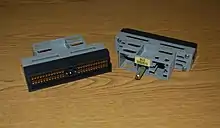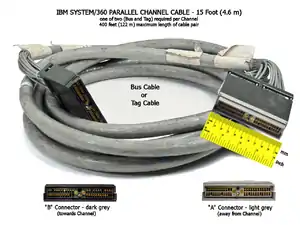Bus and Tag
Bus and Tag is an "IBM standard for a computer peripheral interface",[1] and was commonly used to connect their mainframe computers to peripheral devices such as line printers, disk storage, and magnetic tape drives. The technology[2] uses two[lower-alpha 1] sets of thick, multi-connector copper cables, one[lower-alpha 2] set, carrying data, called the bus, and the other set, carrying control information, called the tag.[3]


Bus and Tag cables are "daisy chained"; and one interface can attach up to eight peripheral control units. The last control unit in the chain must have a terminator plug. Each control unit can attach a number of devices, "sixteen is a typical number."[4] There is an architectural limit of 256 devices per channel, and initially a limitation of 200 feet (61 m), later extended to 400 feet (120 m), between the mainframe and the control unit.[5] Bus and Tag channels handle data rates up to 4.5 MB per second.[6] Only one device can transfer data at a time.[5]
Bus and Tag architecture was also used by other computer manufacturers to attach IBM peripherals to their systems. It was later published by the US National Technical Information Service (NTIS) as FIPS PUB 60-1, I/O Channel Interface.[7]
Bus and Tag was introduced with System/360 in 1964, and was also used with System/370. With the introduction of serial, fiber optic ESCON in the 1990s Bus and Tag channels were re-christened "parallel channels", and were gradually superseded. "Parallel channels are not available on the newest mainframes and are slowly being displaced on older systems."[4] Equipment is available to allow connection of older devices using Bus and Tag to mainframe FICON[8] or ESCON channels.
Example
The following schematic shows a complex system with two CPUs and multiple peripherals connected using bus and tag cabling.

Notes
- Three for a channel with the Two-byte Interface feature.
- Two for a channel with the Interface feature.
References
- IBM Corporation. "IBM Terminology "O"". IBM Globalization. Retrieved Sep 8, 2018.
- IBM System/360 and System/370 I/O Interface Channel to Control Unit Original Equipment Manufacturers' Information (PDF) (Fifth ed.), IBM, January 1978, GA22-6974-4
- PC Magazine. "Definition of: bus and tag channel". Encyclopedia. Retrieved Sep 8, 2011.
- IBM Corporation. "Mainframe hardware: Evolving design". IBM® IBM Knowledge Center. Retrieved Sep 8, 2018.
- Dickens, Steven. "Evolution of z Systems Channel – A Parallel Universe". MAINFRAME DEBATE. Retrieved Sep 8, 2018.
- PC Magazine. "Definition of: parallel channel". Encyclopedia. Retrieved Sep 8, 2018.
- National Technical Information Service (Aug 1979). I/O Channel Interface. Retrieved Sep 8, 2018.
- IBM International Technical Support Organization (April 2018). IBM Z Connectivity Handbook (PDF). p. 193. ISBN 0738443085. Retrieved Sep 8, 2018.
External links
- IBM Corporation (Jan 1978). IBM System/360 and System/370 I/O Interface Channel to Control Unit Original Equipment Manufacturers' Information (PDF). Retrieved Sep 8, 2018.
